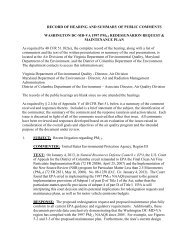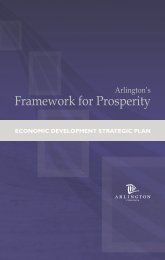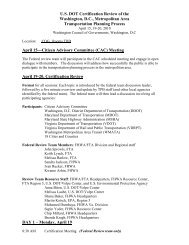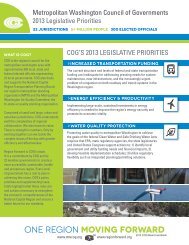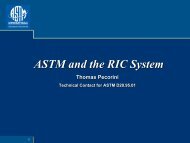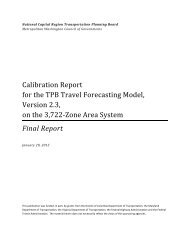PTI Local Government Energy Assurance Guidelines - Metropolitan ...
PTI Local Government Energy Assurance Guidelines - Metropolitan ...
PTI Local Government Energy Assurance Guidelines - Metropolitan ...
You also want an ePaper? Increase the reach of your titles
YUMPU automatically turns print PDFs into web optimized ePapers that Google loves.
■ ■ Office of the Governor: Governors and governors’ offices have the ultimate responsibility for energy<br />
emergency planning. In December 2006, the National Governors Association Center for Best Practices<br />
released the Governors Guide to <strong>Energy</strong> <strong>Assurance</strong> to assist governors in protecting their States’ critical<br />
energy infrastructure and effectively responding to energy emergencies. The level of involvement of a<br />
governor’s office during an energy emergency varies from State to State based on the severity of the situation<br />
and the roles assigned in the State’s emergency plan. Regardless of the hierarchy or degree of the problem, the<br />
governor’s office will usually want to be informed expeditiously.<br />
■ ■ State Department of Agriculture Division of Weights and Measures (ADWM): The ADWM inspects pumps<br />
and meters used for measuring any type of liquid (gasoline, fuel oil, propane) fuel or solid commodities sold<br />
in the State.<br />
■ ■ State Department of Environmental Protection: Many States have an agency or department with the mission<br />
to gather and provide information on energy conservation, energy efficiency, and renewable energy, in<br />
addition to supplying information, statistics, and data on more traditional energy sources. The scope and reach<br />
of topics that are addressed by environmental agencies varies widely from State to State. Many State-level<br />
environmental agencies also regulate air pollutants often produced by energy generation and consumption,<br />
such as carbon monoxide, lead, nitrogen, and the like.<br />
Federal <strong>Government</strong> Contacts<br />
■ ■ U.S. Department of <strong>Energy</strong> (DOE): The Office of Electricity Delivery and <strong>Energy</strong> Reliability (OE) and the<br />
<strong>Energy</strong> Information Administration (EIA) are the primary offices concerned with energy assurance within the<br />
U.S. Department of <strong>Energy</strong>. OE is the primary DOE office that deals with energy emergency planning and<br />
local government EAPs. EIA is the statistics arm of DOE. It has up-to-the-minute energy supply information<br />
available on its website and excellent State energy background information for local EAPs. OE will be a good<br />
resource during EAP development, and EIA may have useful information for this process as well. However,<br />
response-oriented partnerships will be found primarily at the regional or State level. The reason for this is that<br />
Federal resources are typically implemented at the State level.<br />
■ ■ The <strong>Energy</strong> Emergency <strong>Assurance</strong> Coordinators (EEAC) Website: OE maintains a password-protected<br />
EEAC website through which authorized (key) State and local energy emergency coordinators may access<br />
valuable energy security information and resources, including daily news summaries, emergency situation<br />
reports, lessons learned from other cities and States, links to outage and curtailment information, and the<br />
ability to email messages to colleagues in other jurisdictions. The EEAC website is a cooperative effort<br />
among a number of State and local government associations. Each State has designated at least one primary<br />
and one secondary designee for three energy sources (electricity, natural gas, and petroleum) that local<br />
planners may want to establish contact with. The EEAC bulletin board provides a great way for energy<br />
assurance coordinators to share information and best practices. (See Appendix C for further information.)<br />
■ ■ U.S. Department of Homeland Security (DHS): DHS leads the national effort to protect and secure the<br />
country. Some States have developed their own homeland security agencies since September 11, 2001. The<br />
Federal Emergency Management Agency (FEMA) is an agency within DHS that can provide emergency<br />
response support to States, and processes requests for disaster reimbursement. During an energy emergency,<br />
coordination will likely occur with FEMA through the State Emergency Operations Center.<br />
54 | 3 – How to Develop or Enhance a <strong>Local</strong> <strong>Energy</strong> <strong>Assurance</strong> Plan



